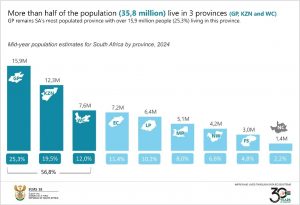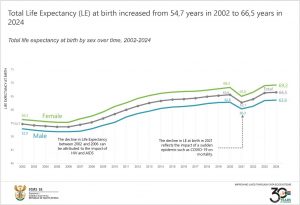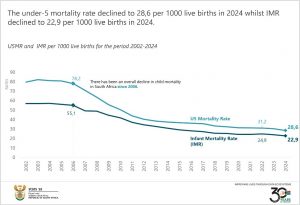South Africa’s population surpasses the 63 million mark
South Africa’s population has now exceeded 63 million, according to the latest mid-year population estimates for 2024. The country’s population grew by approximately 835,513 individuals, marking a 1,33% increase from July 2023 to July 2024. The data reveals that over half of the population is female, totalling around 32 million people.
Provincial population estimates indicate that Gauteng remains the most populous province with nearly 16 million residents. KwaZulu-Natal follows with a population of 12,3 million. Together, these two provinces account for about 45% of South Africa’s total population. In contrast, Northern Cape is the least populated province, housing just under 1,4 million people.
Population resilience post pandemics
Life expectancy, the average number of years a person can expect to live based on current mortality rates, is a key indicator of a population’s health and well-being. In South Africa, life expectancy has increased significantly, reflecting advances in medicine, public health, and socioeconomic development.
South Africa has faced two pandemics between 2002 and 2024. The Acquired Immunodeficiency Syndrome (AIDS) pandemic caused a gradual loss of life over decades, whereas COVID-19 led to a sharp increase in mortality within months.
According to the report, life expectancy at birth is now 66,5 years, a significant increase from the estimated 53,6 years in 2005.
In the South African context, the rise in life expectancy can be attributed to three key trends. Firstly, the expanded rollout of antiretroviral therapy (ART) over time has had a major impact on those living with HIV (Human Immunodeficiency Virus). South Africa has the largest ART program in the world, leading to a reduction in AIDS-related deaths from 284,249 in 2005 (42% of all deaths) to 68,406 in 2024 (12.5% of all deaths).
The second reason is that the uptake of vaccinations and treatments for COVID-19 infections has led to a significant decline in COVID-19 related deaths since July 2021.
Thirdly, the decrease in the infant mortality rate (IMR) from an estimated 57 infant deaths per 1,000 live births in 2002 to 22,9 per 1,000 live births in 2024, has a direct impact on the improvement of Life expectancy at birth. These indices reflect improvements in the overall health and living conditions of the population
The Mid-Year Population Estimates (MYPE) provide critical demographic indicators of recovery, including death rates and growth rates.
The crude death rate (CDR), which measures the annual rate of deaths per 1,000 people, peaked at 11,1 in 2021 during the height of the COVID-19 pandemic. By 2024, the CDR had significantly declined to 8,7, reflecting the positive impact of COVID-19 interventions. Similarly, the estimated annual population growth rate fell to 1,06% in 2020–2021 due to the surge in COVID-19 deaths and a drop in immigration. However, it rebounded to 1,33% by 2024.
The elderly growth rate dropped from 2,88% in 2019–2020 to 1,65% in 2020–2021 due to the pandemic but has since recovered to 2,11% in the 2021–2022 period.
According to the 2024 estimates, about 27,5% of the population is under 15 years old, while approximately 9,7% (6,1 million) are aged 60 years or older. Among those under 15, the majority reside in KwaZulu-Natal (21,4%) and Gauteng (21,3%). For the elderly, the highest percentage, 24,8% (1.52 million), live in Gauteng. Detailed population estimates by age, sex, and geography are essential for guiding economic and social investments to enhance the quality of life of all South Africans.
For more detailed information please download the full report here.




